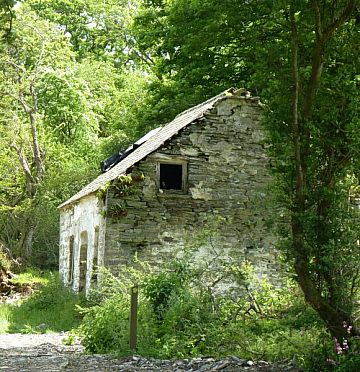When I first started writing, it was fantasy that inspired me, but somewhere along the way, I realised that fantasy works best when it best reflects real life, and that real life can be fantastical enough for me.

I moved to my present home, deep in the wooded countryside of north Pembrokeshire, and during one of my tramps among the surrounding fields, I came upon a cottage, lost in a deep dell, completely engulfed in trees. It was small, dark, derelict and it must have been abandoned at least fifty years before, but the ghost of occupation was still there, fossilised in stone. The upper floor had collapsed, but under the beams and rotting boards, I could just glimpse flagstones, a broken chair leg, the rusting grill of a hearth from which a family had once been fed.
This is what truly fascinates me: the hand of the past on the present. In the case of the cottage, it was a physical touch, a slate and timber memorial to past lives that would continue to occupy that secret corner of the woods for years to come, until time and weather and tree roots finally reduce it to rubble. But it was a reminder of the way brief human lives, their small adventures and little dramas live on too in the impact they have, the scarcely significant rearrangement of atoms that result from their passage through time and space, even when names or words or events are long forgotten.
We are all the product not just of our own past but of the past lives of all who came before us. Who can tell where each of us would be if a grandmother had chosen this or a great grandfather had not done that. The mere fact that we no longer have any idea what this or that might have been merely adds to the mystery.

It is this notion that partly inspired the writing of A Time For Silence (published 2012 by Honno Press). My main character Sarah discovers a family secret that she had never suspected and she sets out to investigate, but even though she is the end product of it all, what hampers her, more than the refusal or inability of others to speak about it, is her own misconceptions as she tries to piece together past lives that are utterly beyond her experience.
The other inspiration for the book came from two other sources. There was a piece of local gossip about another house in the area where I live – ‘You know that place down there? Well, apparently…’ Apparently it remains, because I’ve never found any concrete proof of what I was told, but I immediately associated the gory tale with the image of the ruined cottage in the woods and began imagining how it could have happened, and why, and what the ramifications might have been. More importantly, I was intrigued as to how an entire community could have kept quiet about it.
Then there was an old newspaper story that I came upon by chance while researching something else. It was a brief court report from the 1950s of a young girl hauled before the local magistrates for the crime of attempting suicide. The way her “crime” and her counter-allegations were treated is no longer remotely comprehensible in the 21st century, because our perceptions and attitudes are so utterly different.
I instantly wanted to know what had happened, what the final outcome had been when her sentence had been served, what sort of life the girl had gone on to lead. It was clear that though the JPs had tried to manipulate an outcome to solve a problem no one wanted to acknowledge, justice had not been on the side of the child. It vexed me so much that I was determined to write in order to give her the voice she was denied.
A very presumptuous wish, but then I suppose anyone who writes a novel has to be presumptuous to think she has something to say worth reading. Being a newly published author, when A Time For Silence was published, in 2012, I was so deeply conscious of my presumption that I was in a flap of nervous relief whenever readers told me that they enjoyed it (still am). Which means I was utterly delighted to find that I’ve been voted a finalist for the People’s Book Prize (and then runner up for the Beryl Bainbridge award).I like to think that the votes I received were a small token of justice for the unnamed girl in the newspaper article.

It has been really interesting to read about your inspirations for ‘A Time For Silence’, – Just a chance find of a tumbledown cottage and what a brilliant story you have woven from this discovery.
LikeLike
Thank you, Elizabeth. Tumbledown cottages do that for me. 🙂
LikeLike
I had to look twice at the date of that horrific report – the 1950s. Shocking to think how recently people accepted attempted suicide as a crime. I love the way you weave historical detail and mores into your books.
LikeLike
I know, it is horrific, isn’t it? I imagine that was why the verdict of suicide while the balance of the mind was disturbed was so common – so that successful suicides wouldn’t be recorded as criminals. Of course, attempting or committing suicide is not a crime now, but helping them is.
LikeLike
Fascinating… but what else would I expect. A great [post.
LikeLike
thanks, Judith
LikeLiked by 1 person
Just managed to reblog! Only took four hours…
LikeLiked by 1 person
😀
LikeLiked by 1 person
Reblogged this on Judith Barrow.
LikeLike
Well done. I think it’s all down to the alignment of the stars.
LikeLike